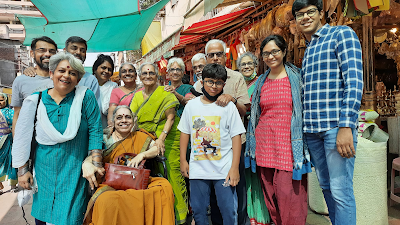Visiting major pilgrimage sites is always an ordeal due to crowds and endless queues. But Pandharpur is an easy experience.
 |
| Our family in front of the temple, three generations |
For those on wheelchairs there are special arrangements for quick darshan. No photography allowed inside, so this is the exterior.
 |
| First sight of Namdev and Chokha Mela shrines |
Namdev Payri is the samadhi sthal of the saint Namdev. "Jivanta Samadhi" was taken by 13 members of his family and Janabai in this place. The smaller shrine is of the poet Chokha Mela, who was one of the many followers of Namdev. His song Abir Gulal Udalita Rang is well known and widely sung. Being from a low caste, he was denied access to the temple. His bones were buried outside the temple, and many visit this spot where there is a small shrine. One cannot get away from caste and its hold... even in the India of today. Although things have improved a lot, there is still a lot of discrimination.
 |
| Guava seller outside the temple |
Guava is called Peru in Maharashtra. The term is likely derived from the source / origin of the fruit... they are from Central America / Mexico and were introduced into India in the 1600s by the Portuguese. Peru + masala... great combo.
Tukaram sings:
Gopichandan-uti tulasichya mala haar milwiti gala,
Taal mrudung ghai pushpa varshav,
Anupamya sukhasola re
The pilgrims have anointed themselves with sandalwood paste and put on garlands of basil leaves. Drums are reverberating and flowers are being showered. The joyous celebration is beyond words.
The pilgrimage experience includes getting markings on ones hands and forehead. Experiencing Vitthala not only through the eyes (darshan) but also through one's own body.
Little boys come running with pastes and metal moulds when you reach the temple. The most popular are the Vaishnavite urdhva pundra marks on the forehead, but arms are also decorated with outlines of Vithhala or the temple or other sacred symbols.






No comments:
Post a Comment